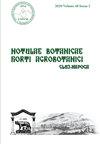绿色纳米技术在谷类作物细菌性病害管理中的应用:金属基纳米颗粒研究进展
IF 1.3
4区 生物学
Q3 PLANT SCIENCES
引用次数: 0
摘要
谷物是动物的重要营养来源。几种病害对谷类作物造成严重的产量损失。细菌性病害导致不同谷物的产量损失:小麦(5-40%)、玉米(15-98.9%)、水稻(20-70%)、珍珠粟(3-35%)和燕麦(15-49%)。疾病可能是细菌性疾病,真菌或病毒。细菌性疾病传统上是用杀虫剂治疗的。化学合成的农药是有毒的,对环境有害。纳米技术作为一种强有力的抗菌剂,在农业领域,尤其是在植物病理学领域是一个新兴的新兴领域。纳米粒子的合成方法多种多样,如生物、物理和化学方法。化学和物理方法制备纳米颗粒成本高,而且对环境有害。生物合成纳米颗粒的方法既环保又经济。微生物或植物提取物用于金属纳米颗粒的合成。纳米粒子在农业中的应用范围广泛,可能带来纳米革命。本文综述了生物合成金属纳米颗粒的抗菌活性及其在谷物细菌性病害防治中的作用。本文章由计算机程序翻译,如有差异,请以英文原文为准。
Green nanotechnology for plant bacterial diseases management in cereal crops: a review on metal-based nanoparticles
Cereals are an important source of nutrients for animals. Several diseases cause severe yield loss in cereal crops. Bacterial diseases result in varying yield losses across cereals: Wheat (5-40%), maize (15-98.9%), rice (20-70%), pearl millet (3-35%), and oats (15-49%). Diseases may be bacterial diseases, fungal or viral. Bacterial diseases are traditionally treated by pesticides. Chemically synthesized pesticides are toxic and hazardous to the environment. Nanotechnology is emerging and novel field for agriculture, especially in plant pathology as a strong antimicrobial agent. Nanoparticles have been synthesized in various ways i.e., biological, physical, and chemical methods. Chemical and physical methods of nanoparticles are costly and toxic to the environment. The biological method for the synthesis of nanoparticles is eco-friendly and economical. Microorganisms or plant extracts are used for metal nanoparticle synthesis. The application of nanoparticles in agriculture has a wide scope and it can bring nano-revolution. This review summarizes the antibacterial activity of biosynthesized metal nanoparticles and their role in bacterial disease management of cereals.
求助全文
通过发布文献求助,成功后即可免费获取论文全文。
去求助
来源期刊

Notulae Botanicae Horti Agrobotanici Cluj-napoca
PLANT SCIENCES-
CiteScore
2.70
自引率
0.00%
发文量
118
审稿时长
3 months
期刊介绍:
Notulae Botanicae Horti Agrobotanici Cluj-Napoca is a peer-reviewed biannual journal aimed at disseminating significant research and original papers, critical reviews and short reviews. The subjects refer on plant biodiversity, genetics and plant breeding, development of new methodologies that can be of interest to a wide audience of plant scientists in all areas of plant biology, agriculture, horticulture and forestry. The journal encourages authors to frame their research questions and discuss their results in terms of the major questions of plant sciences, thereby maximizing the impact and value of their research, and thus in favor of spreading their studies outcome. The papers must be of potential interest to a significant number of scientists and, if specific to a local situation, must be relevant to a wide body of knowledge in life sciences. Articles should make a significant contribution to the advancement of knowledge or toward a better understanding of existing biological and agricultural concepts. An international Editorial Board advises the journal. The total content of the journal may be used for educational, non-profit purposes without regard to copyright. The distribution of the material is encouraged with the condition that the authors and the source (Notulae Botanicae Horti Agrobotanici Cluj-Napoca or JCR abbrev. title Not Bot Horti Agrobo) are mentioned.
 求助内容:
求助内容: 应助结果提醒方式:
应助结果提醒方式:


